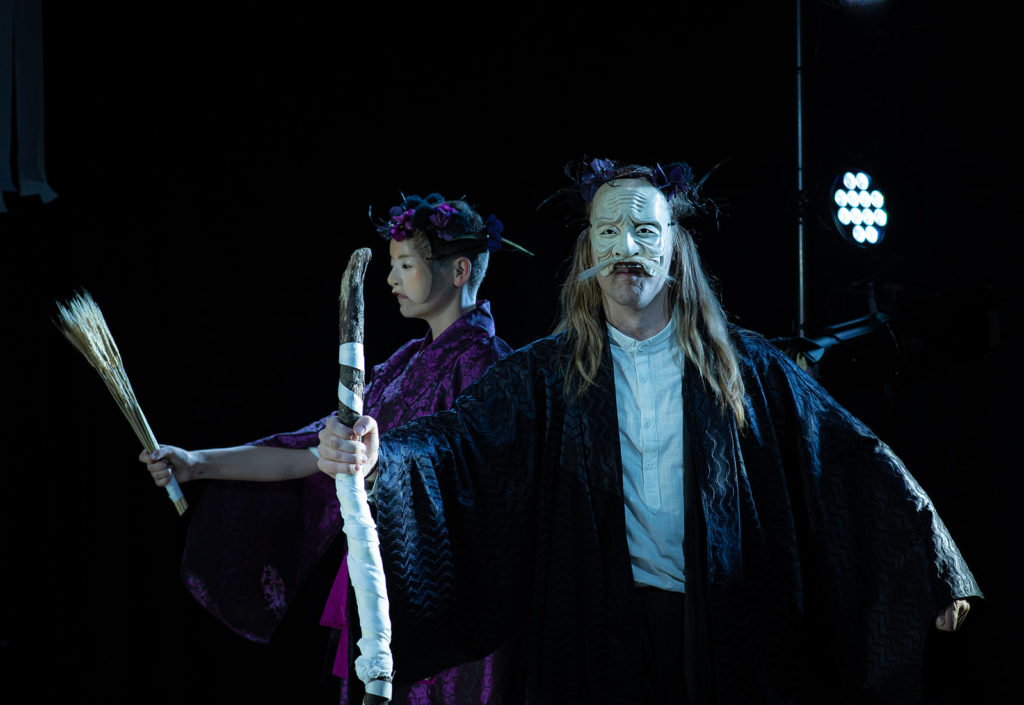Monteverdi meets Noh theater with IN Series’ imaginative “Orpheus”

Janna Critz as Proserpina (left) and Robin McGinness as Pluto in “The Nightsong of Orpheus” presented by IN Series Friday night at Source Theatre. Photo: Bayou Elom
At the tail end of the Renaissance, Florentine humanists created the first operas in an attempt to revive the art of the ancient Greek tragedy. A new production from the IN Series and Theatre Nohgaku called The Nightsong of Orpheus, which opened Friday night at Source Theatre, melds Claudio Monteverdi’s first opera, L’Orfeo, with a more recent tradition from Japan, Noh theater. It may not be for purists devoted to either Noh or Monteverdi but it makes an intriguing night in the theater.
Director Timothy Nelson has preserved most of the arc of Monteverdi’s familiar opera, which premiered in 1607. Onto Christopher Cowell’s English translation of the libretto Nelson has grafted a few selections from Monteverdi’s 1610 Vespro della Beata Vergine. These excerpts are sung to a Japanese text by Eiki Isomura, regrettably without any translation provided, either in the program or through supertitles.
Tenor Tony Boutté clearly had an off night as Orpheus, the top notes underpowered with small cracks at register shifts. This made “Possente spirto,” the character’s showpiece aria, a bit underwhelming vocally. Such powerful music that it convinces Charon to take Orpheus across the Styx into the underworld, Orpheus sang it in this version to no one, as Charon and his music were excised. Violinists Daniel Boothe and Claudia Combs did most of the enchanting, playing their paired echo parts while walking around the edge of the stage space.
The rest of the cast fared much better, sounding impressively strong and unified especially as an ensemble in the choral numbers like “Deus in adjutorium,” the opening borrowed from Monteverdi’s Vespers. Mezzo-soprano Aryssa Leigh Burns shone brightest, with among others, an excellent turn as La Speranza, the allegorical figure who accompanies Orpheus into the underworld. The character is humorously turned back by the famous line Dante placed on the gate of hell in Inferno, “Abandon hope, all you who enter here,” quoted with great solemnity. (In an interesting twist, Burns will sing the role of Orpheus at some performances.)
Mezzo-soprano Janna Critz struggled with intonation as well at times but made a gorgeous duet with Burns in “Pulchra es,” another piece borrowed from the Vespers. By the second act, Critz was in regal form as Proserpina, herself moved by the music of Orpheus to convince Pluto to allow Orpheus to lead the shade of his wife, Eurydice, from the underworld. Baritone Robin McGinness matched her in potency as Pluto.
Tenor Oliver Mercer carried much of the musical weight throughout the evening, providing a puissant climax as the voice of the god Apollo, which was acted strikingly on stage by the Noh performer Akira Matsui from Theatre Nohgaku. The insertion of “Duo seraphim” from the Vespers stole some of the thunder from Orpheus’s “Possente spirto,” which followed it, but Mercer gave this sublime piece a lyrical beauty.
Countertenor Hunter Shaner emerged from the ensemble as the Messenger, transformed into a woman by his Noh mask and costume. With shrieking high notes and static Noh-influenced movements (directed by Jubilith Moore of Theatre Nohgaku), Shaner made exactly the sort of show-stopping intervention as the mysterious visitor who informs Orpheus that his wife has died of a snake bite during their wedding party.
Soprano Mara Yaffee made a tragic Eurydice, echoing Orpheus in another piece inserted from the Vespers, “Audi coelum,” in which she took the echo part in answer to her husband, leading her from the underworld. This piece, although gorgeous, seemed again like gilding the lily, as it was then followed by the echo aria from L’Orfeo, “Questi i campi di Tracia.”
Nelson conducted the evening, also playing both organ and harpsichord, doubled more confidently by Emily Baltzer on another harpsichord. The small INnovātiō Baroque Orchestra conveyed a lean sense of the score, with two violins, two gambas, and theorbo. Although the cornettos and other instruments usually heard in Monteverdi were missed, Richard Emmert added an unclassifiable element on two instruments from the Noh tradition, the shrill flute (fue) and imposing drum (taiko). Only when Emmert tried to play the fue along with the baroque instruments did worlds collide due to brutal intonation clashes.
The action unfolded on a long wooden platform, with the audience seated in a few rows on either side (scenic and costume design by Debra Kim Sivigny). Paper covered the stage, on which the cast painted some calligraphic characters, later ripping it up at the opera’s tragic conclusion. Long strips of black cloth, waved through the air by the singers, evoked the waves of the Styx in a memorable moment. Paul Callahan’s lighting added golden touches and conjured up the darkness of the underworld.
Nelson’s cross-cultural mash-up was, in the end, remarkably effective. Long stretches of the least pleasing parts of L’Orfeo, the recitatives, were eliminated in favor of much more complicated music from the Vespers. The ritual parts of Noh theater, the masks and the deliberate movements, gave visual punch back to the supernatural elements of the Greek story, so familiar to audiences that they are often underwhelming.
The juxtaposition of the opera and the sacred Vespers was a reminder that several months after the Mantua premiere of L’Orfeo, in February of 1607, Monteverdi himself lost his wife, who died suddenly that September. It was purely a coincidence, but the composer likely remembered the suffering of his operatic character in the face of his own grief.
The Nightsong of Orpheus runs through September 25, in different venues and casting. inseries.org
